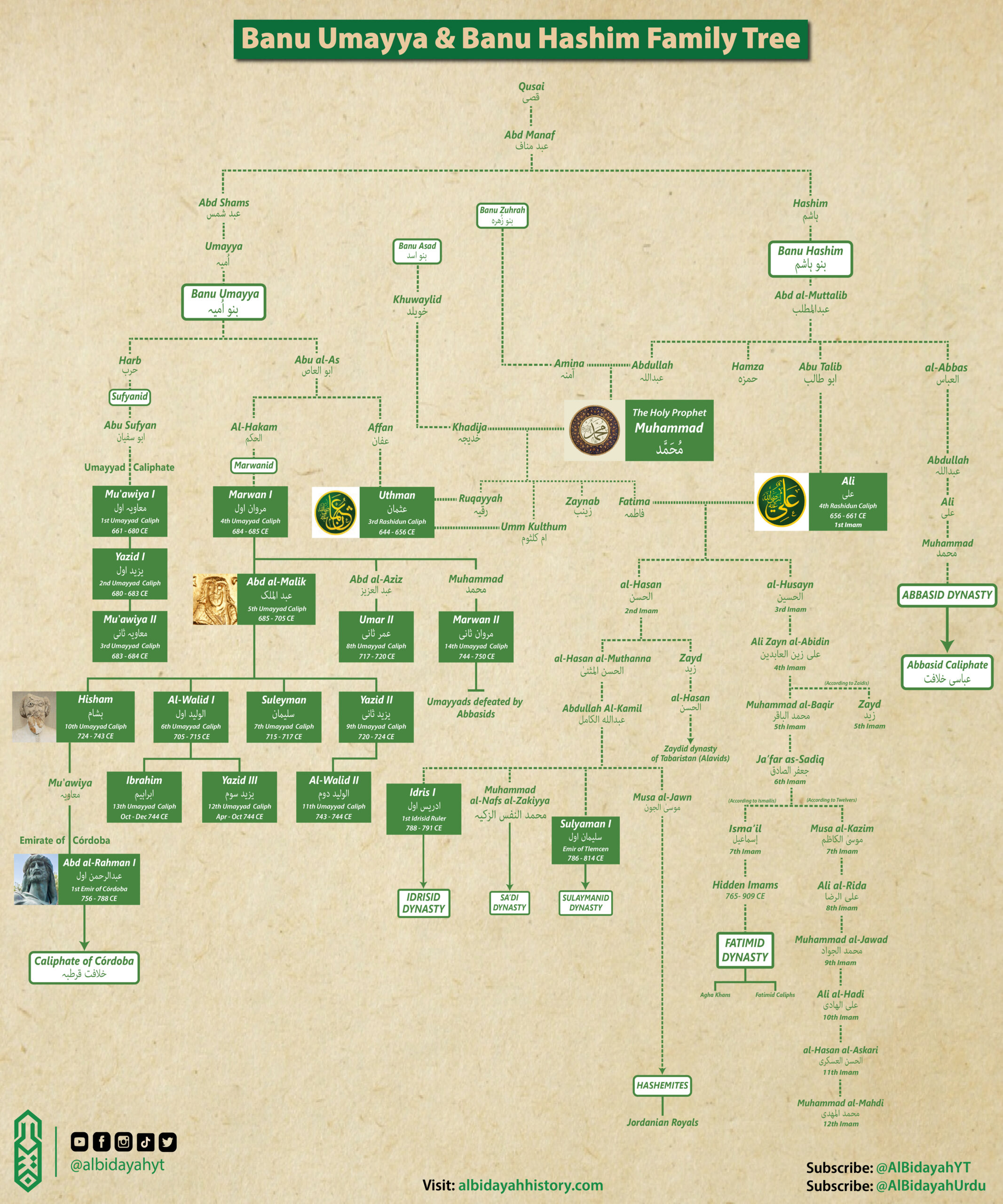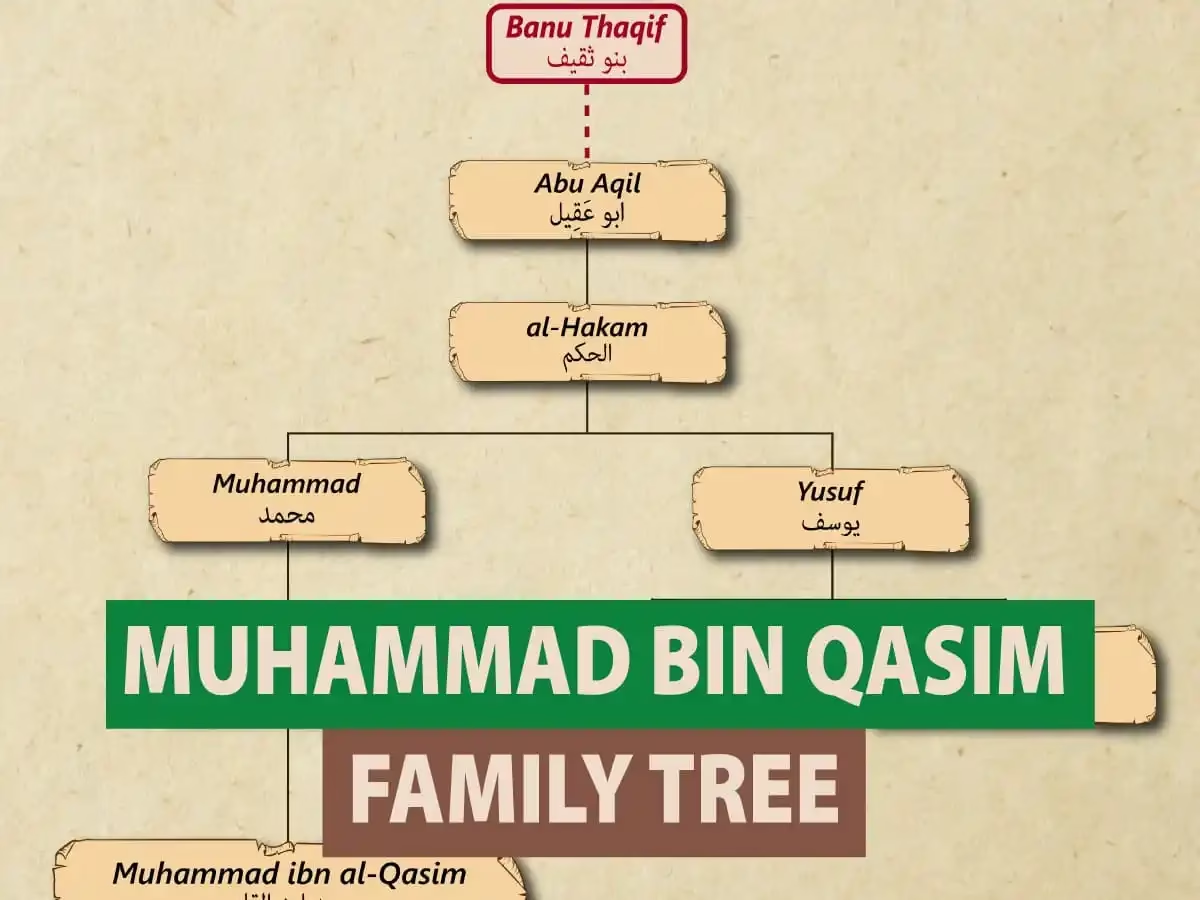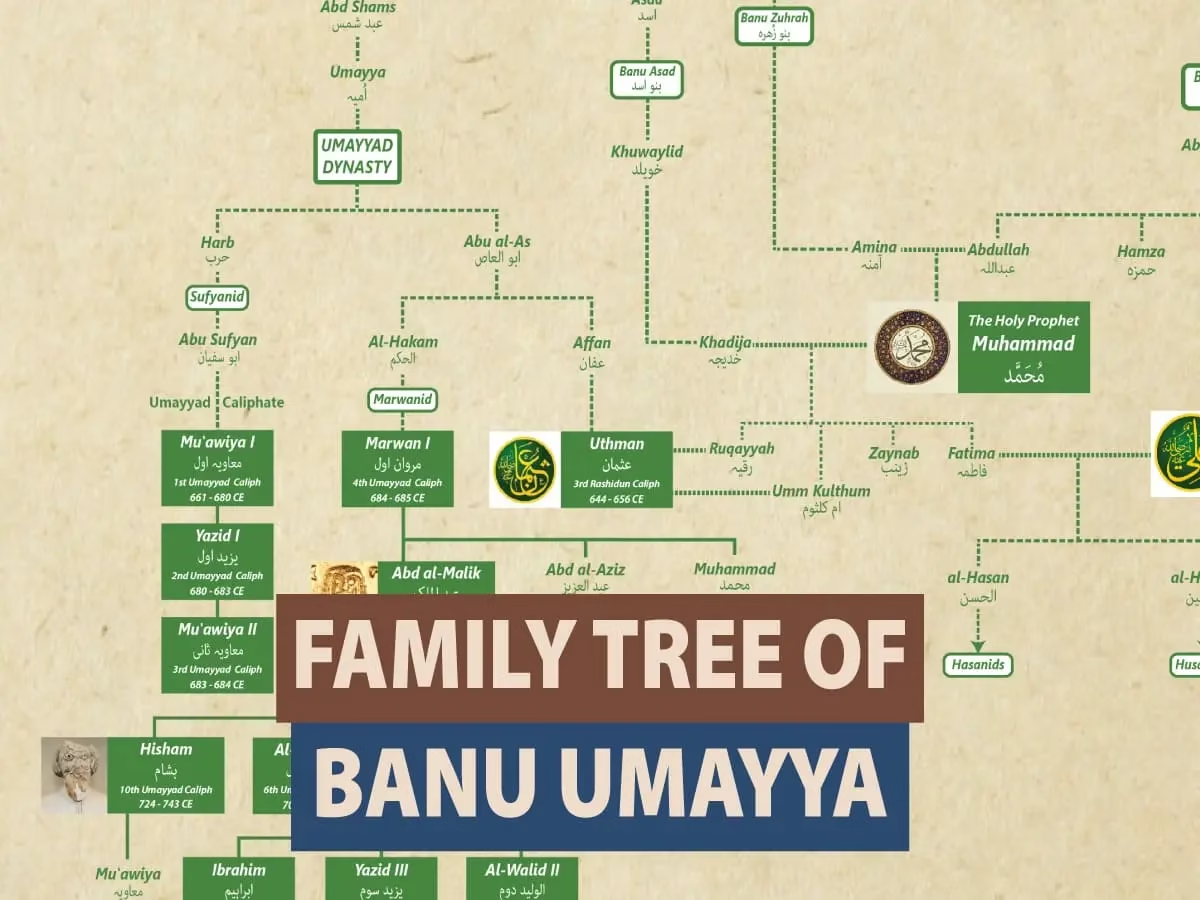The family tree of Banu Umayya and Banu Hashim (English and Urdu), represents one of the most significant genealogical records in Islamic history. It highlights the lineage of two prominent Qurayshite clans and their impact on early Islamic politics, leadership, and governance. Both clans trace their ancestry back to Abd Manaf ibn Qusay, a key patriarch of the Quraysh tribe.

The Division of Abd Manaf’s Descendants
The lineage diverges from Abd Manaf, a son of Qusai. Abd Manaf had several sons, including two named, Hashim and Abd Shams, who became the progenitors of Banu Hashim and Banu Umayya, respectively. Their descendants played pivotal roles in the spread and governance of Islam, often acting as rivals throughout history.
- Banu Hashim produced the Prophet Muhammad (peace be upon him) and several key Islamic figures, including Ali ibn Abi Talib, the fourth caliph and cousin of the Prophet.
- Banu Umayya, on the other hand, dominated the early Islamic caliphate through the establishment of the Umayyad Dynasty.
Banu Hashim: The Line of Prophethood and Abbasid Caliphate
Banu Hashim is most famously associated with Prophet Muhammad (peace be upon him), whose teachings and leadership established the foundation of Islam. The tree shows his lineage and close relatives:
- Abdullah, his father, was the son of Abd al-Muttalib.
- Ali ibn Abi Talib, the Prophet’s cousin and son-in-law, married Fatimah, the Prophet’s daughter, giving rise to the lineage of Imams.
Key branches of Banu Hashim include:
- The Abbasid Dynasty, which succeeded the Umayyads and ruled the Islamic world from 750 CE.
- The Fatimid Dynasty, founded in North Africa, claiming descent from Ali and Fatimah.
- The Hashemites, the modern Jordanian royal family, also trace their lineage to Banu Hashim.
See Also: Prophet Muhammad (PBUH) Family Tree: Quraysh to Imam Mahdi
Key Figures from Banu Hashim
1. Prophet Muhammad (PBUH)
The founder of Islam and the final Prophet, Muhammad’s teachings became the foundation of a global religion. He not only preached monotheism but also established the first Islamic state in Medina, uniting Arabian tribes under one faith.
2. Ali ibn Abi Talib
Ali, the cousin and son-in-law of the Prophet, was a remarkable leader, warrior, and scholar. He became the fourth Caliph and is revered by Shi’a Muslims as the first Imam. Known for his bravery, wisdom, and justice, Ali left a lasting impact on Islamic governance and spirituality.
3. Fatimah bint Muhammad
Fatimah, the daughter of the Prophet and wife of Ali, is celebrated for her piety and devotion. Her sons, Hasan and Husayn, continued the legacy of Banu Hashim. She is a revered figure in both Sunni and Shi’a Islam.
4. Hasan ibn Ali
As the Prophet’s eldest grandson, Hasan became a symbol of peace when he made a treaty with Muawiya I to end the first civil war in Islam. His actions preserved unity among Muslims during a time of great tension.
5. Husayn ibn Ali
Husayn’s martyrdom at the Battle of Karbala is one of the most significant events in Islamic history. He stood against tyranny and sacrificed his life for justice, becoming a symbol of resistance for Shi’a Muslims and an inspiration for all who value righteousness.
6. Abbas ibn Abd al-Muttalib
The uncle of the Prophet, Abbas is the ancestor of the Abbasid Caliphs, who ruled much of the Islamic world for centuries. His descendants shaped the political and cultural landscape of the Islamic empire.
7. Abdullah ibn Abbas
A cousin of the Prophet, Abdullah ibn Abbas is remembered as a brilliant scholar and interpreter of the Quran. His teachings and explanations are foundational for Islamic studies.
Banu Umayya: Power and Politics
The Banu Umayya clan, starting with Umayya ibn Abd Shams, established the first hereditary Islamic dynasty. The Umayyad Caliphate ruled from 661 to 750 CE, with its capital in Damascus. Key figures include:
- Muawiya I (661–680 CE) – The first Umayyad caliph, who established dynastic rule after the assassination of Ali.
- Yazid I – Notorious for his role in the Battle of Karbala against Husayn ibn Ali, the grandson of the Prophet.
- Abd al-Malik ibn Marwan – Known for consolidating Umayyad rule and initiating architectural projects like the Dome of the Rock.
- Hisham ibn Abd al-Malik – One of the longest-reigning Umayyad caliphs, overseeing a period of expansion and administrative reform.
The Umayyad rule ended in 750 CE, with many surviving members fleeing to Al-Andalus (modern-day Spain), where they established the Caliphate of Cordoba.
See Also: Shia Imams Family Tree
Key Figures from Banu Umayya
1. Muawiya ibn Abu Sufyan
Muawiya I was the founder of the Umayyad dynasty and its first Caliph. Known for his political skills, he moved the capital to Damascus and created a centralized government, laying the groundwork for dynastic rule in Islam.
2. Yazid ibn Muawiya
Yazid I is remembered for his controversial role in the Battle of Karbala, where Husayn ibn Ali was martyred. His reign marked a turning point in Islamic history.
3. Abd al-Malik ibn Marwan
As the fifth Umayyad Caliph, Abd al-Malik brought significant reforms. He made Arabic the official language of administration, introduced Islamic coinage, and commissioned the iconic Dome of the Rock in Jerusalem.
4. Al-Walid I
Under Al-Walid’s leadership, the Umayyad Caliphate expanded to Spain, Sindh (India), and Central Asia. He also promoted architecture, building the stunning Great Mosque of Damascus.
5. Umar II
Often called the “Sixth Rightly Guided Caliph,” Umar II was known for his piety and justice. He worked to reduce discrimination against non-Arab Muslims and focused on governance based on Islamic principles.
6. Abd al-Rahman I
After the fall of the Umayyad Caliphate in the East, Abd al-Rahman escaped to Spain and founded the Umayyad Emirate of Cordoba. This laid the foundation for a flourishing Islamic civilization in Al-Andalus.
A Legacy of Rivalry and Contribution
The rivalry between Banu Hashim and Banu Umayya is well-documented in Islamic history. While Banu Hashim focused on spiritual and religious leadership, Banu Umayya excelled in political and military dominance. Key events, such as the Battle of Siffin and the Battle of Karbala, highlight the tensions between these clans, but their contributions to Islamic history remain unparalleled.
- Banu Hashim: Known for their spiritual and religious influence, including the Prophethood and the lineage of Imams. They are revered for their moral leadership and scholarly contributions.
- Banu Umayya: Celebrated for their administrative and military achievements, which expanded the Islamic empire and brought structure to governance.
See Also: Abu Bakr Family Tree



